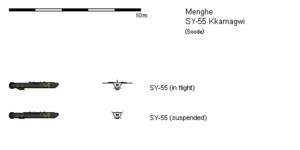SY-55 Kkamagwi
| SY-55 Kkamagwi | |
|---|---|
 | |
| Type | Air-launched cruise missile |
| Place of origin | Menghe |
| Service history | |
| In service | 2019-present |
| Production history | |
| Manufacturer | Buksŏng Industries Group |
| Unit cost | ₩32,300,000 ($1,430,000) |
| Specifications | |
| Weight | 645 kg |
| Length | 3.76 m |
| Height | 400 mm |
| Warhead | 350 kg two-stage penetrating warhead |
| Engine | Donghae Gi-3-105 turbojet |
| Wingspan | 840 mm |
Operational range | 270 km |
| Speed | Mach 0.8 |
Guidance system | CSNS and inertial guidance, terminal contrast seeker |
Launch platform | Songrim SR-8 Daesŭngri DS-9 Songrim SR-12 |
The SY-55 Kkamagwi (Menghean: crow) is a Menghean air-launched cruise missile developed by the Buksŏng Industries Group. It was first revealed in 2017 and entered service in 2019. It is derived from the SY-53 Pok-u, and uses the same engine, wing plan, and guidance system, but differs in featuring a more compact body with a ground-penetrating unitary warhead rather than the SY-53's submunition options. It incorporates low observable technology, including radar-absorbent materials and an angular planform, giving it a greater chance of slipping past enemy early warning radar undetected.
Description
Propulsion
The SY-55 is powered by a Donghae Gi-3-115 turbojet engine, an improved version of the model used by the YDH-26 anti-ship missile and SY-53 Pok-u cruise missile. The Gi-3-115 develops 3.2 kN of thrust and has improved thrust-specific fuel consumption. Along with the more streamlined body and larger fuel tank, this improvement supports an increase in range to 270 kilometers, allowing aircraft carrying the SY-55 to execute strikes from outside the range of S-300 and COFFIN-ER SAM batteries.
The two wings folded along the upper surface of the SY-55 unfold once the missile is released from its hardpoint. Once its turbojet engine activates, the SY-55 descends to a sea skimming or terrain-following altitude, executing a low-level approach to further reduce its exposure to enemy radar and air defenses.
Guidance
The basic guidance system of the SY-55 is carried forward from the SY-53 missile. CSNS provides the main mid-course guidance mode, while a backup inertial navigation system provides guidance if the CSNS signal is jammed or if the satellites in the CSNS constellation are damaged. These guidance systems allow the operator to program a multi-leg approach trajectory with mid-course updates, to approach the target from an off-bearing direction or exploit the radar shadow created by terrain.
In the final approach phase, the SY-55 activates an infrared camera in the nose for additional terminal guidance. This infrared imaging guidance system can detect the target's infrared signature, cross-reference the surrounding terrain against pre-programmed information, and update the missile's course accordingly. Compared to a purely CSNS-based terminal mode, this option allows the SY-55 to strike targets with imprecise coordinates and increases resistance to jamming. It also allows the missile to strike moving vehicles and surface ships, though more efficient missile and bomb options exist for both target types. If the assigned target, such as an underground bunker, has no infrared signature, the missile is programmed to follow CSNS for its entire course.
Warhead
The SY-55 uses a 350-kilogram warhead consisting of an initial shaped charge followed by a thermobaric blasting charge. The shaped charge is designed to blow a hole through earth, concrete, brick, or armor plate, allowing the follow-up charge to penetrate through the hole and detonate within. This makes the missile effective against underground bunkers, hardened aircraft hangars, and other thick-walled structures. The use of a thermobaric charge provides an added degree of effectiveness against enclosed fortifications.
Against underground targets, the missile performs a terminal "pop-up" maneuver in order to descend vertically onto the target on impact, reducing the necessary penetration distance compared to a shallow descent from a terrain-following approach.
Launch platforms
The SY-55 has the same mass, interface, and volumetric footprint as the SY-53, and can be carried by the same aircraft.